

JerseyJazz THE MAGAZINE OF THE NEW JERSEY JAZZ SOCIETY OCTOBER 2022 VOLUME 50 ISSUE 9
NJJS 50th ANNIVERSARY
THE LEGENDS
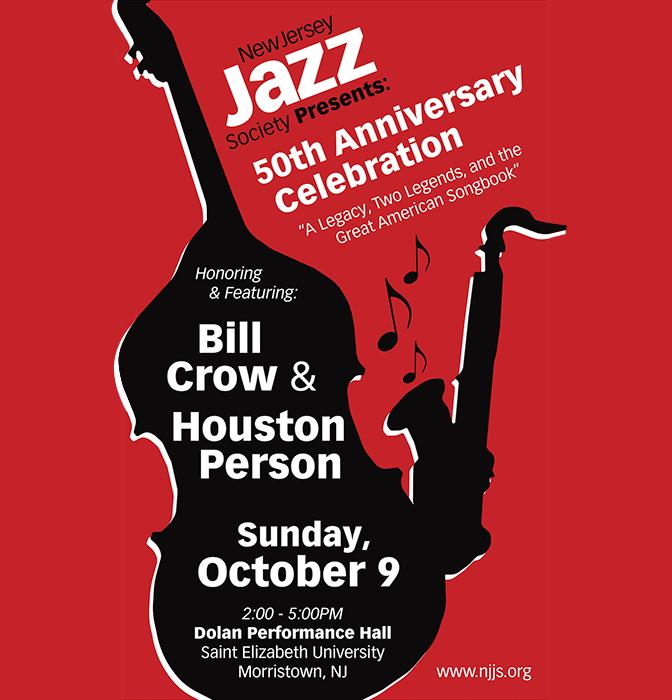
Art Show/Sale & Memorabilia Stroll 2:30
Concert Hall Doors Open 3:00–5:00
Concert 5:00–5:30
Art Show & Memorabilia Stroll FOR TICKETS
NJJS.org $35 General Admission • $15 Students
There is ample FREE parking at Dolan Hall. The concert is open seating.
Vaccination Required / Masks Optional.
COME CELEBRATE OUR GOLDEN ANNIVERSARY! 2:00–3:00
:
A Legacy, Two Legends, and the Great American Songbook
Come join us on Sunday, October 9, to celebrate the 50th Anniversary of the New Jersey Jazz Society! We will be paying tribute to two Living Legends – bassist Bill Crow and tenor saxophonist Houston Person. It’s all happening in Morristown, from 2-5 p.m. in Saint Elizabeth University’s Dolan Hall. Tickets, which are $35 ($40 at the door) for Adults and $15 ($20 at the door) for Students, can be ordered by logging onto www.njjs.org. (For more about Crow, Houston, and NJJS’ legacy, see ‘Honoring Two Living Legends’, page 13).
Crow and Houston will be joined by an all-star supporting cast, led by Co-Musical Directors, tenor saxophonist/flutist Don Braden and pianist Larry Fuller. Braden has been
leading his own bands for more than three decades and has worked as a sideman for vocalist Betty Carter, trumpeter Freddie Hubbard, and drummer Roy Haynes. Fuller has served as vocalist Ernestine Anderson’s Musical Director and played with bassist Ray Brown, drummer Jeff Hamilton and guitarist/vocalist John Pizzarelli.
Said Fuller: “We will be sticking to a program of Great American Songbook tunes, and one of the tunes I play will be an arrangement of Ray Brown’s on (George Gershwin’s) ‘But Not For Me’.” Braden added that he is looking forward to an “expressive, creative and swinging party!”
The MC for the afternoon’s festivities will be producer, author, and
music historian Chuck Granata. Granata has written four books on music and sound recording and has contributed to and supervised the creation of dozens of album projects.
Joining Crow, Person, Braden, and Fuller onstage will be a combination of musical veterans and rising stars:
Cornetist Warren Vache
Bassist Matthew Parrish
Drummer Jason Tieman
Vocalist Lucy Wijnands
Keyboardist Leonieke Scheuble
Trumpeter Liam Sutcliffe
Vocalist/Composer Jimmy Waltman
Bassist Sam AuBuchon
Guitarist/Composer Derick Campos
In the mid-1970s, Vache began playing with the Benny Goodman band on the recommendation of veteran guitarist Bucky Pizzarelli. As a result, he found himself in the company of such other stellar players as pianist Hank Jones, trombonist Urbie
Green, and tenor saxophonist Zoot Sims. Parrish, who has been playing with Person’s quartet for more than a decade, has performed or recorded with such jazz luminaries as trumpeters Harry “Sweets” Edison and Clark Terry and alto saxophonist Lou Donaldson. Tiemann has performed with saxophonist Benny Golson, pianist Harold Mabern, and trombonist Slide Hampton, among many others.
Wijnands was the winner of the 2021 Blues Alley Jazz Society’s Ella Fitzgerald Jazz Vocal Competition. Scheuble, who started to play piano after being inspired by the movie, Ray, has recently been named a Hammond Artist by Hammond USA, manufacturer of the Hammond Organ. She leads the Generations of Jazz Trio, which includes Bill Crow as the bassist.
Sutcliffe, Waltman, AuBuchon, and Campos are winners of the 2022 NJJS Juried Scholarships.
03 OCTOBER 2022 JERSEY JAZZ NJJS.ORG
NJJS 50TH ANNIVERSARY

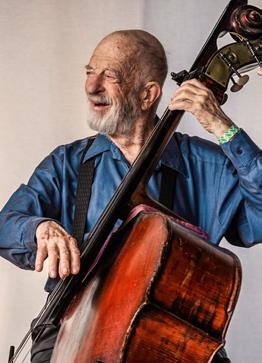
04 OCTOBER 2022 JERSEY JAZZ NJJS.ORG
ARTICLES/REVIEWS 09 Jazz on a Sunday Afternoon: Champian Fulton 10 Big Band in the Sky: Ramsey Lewis 13 NJJS 50th Anniversary 19 Talking Jazz: Marty Grosz 25 Jazz at the Pollak and SOPAC: Bela Fleck and Abigail Washburn 29 Rising Star: Alvaro Caravaca 33 Jazz Education: Ingrid Jensen 38 Other Views 42 Big Band in the Sky COLUMNS 05 Editor’s Choice 36 From the Crow’s Nest 46 Not Without You ON THE COVER Houston Person (left) and Bill Crow PERSON PHOTOGRAPHED BY JOHN HESTER AT THE CENTRAL JERSEY JAZZ FESTIVAL IN NEW BRUNSWICK; CROW PHOTOGRAPHED BY ALLISON BROWN AT THE OSPAC JAZZ FESTIVAL IN WEST ORANGE
IN THIS ISSUE
EDITOR’S CHOICE
BY SANFORD JOSEPHSON
Festival Month Revisited
Last month was chock full of jazz festivals in the Garden State.
The September Jersey Jazz previewed the Central Jersey Jazz Festival in Flemington, New Brunswick, Metuchen, and Somerville; the Montclair Jazz Festival; the Morristown Jazz & Blues Festival; and the Jazz & Roots Festival at Kean University’s East Campus in Hillside.
One festival we missed—because we didn’t learn of its resurgence until after publication—was the OSPAC Jazz Festival on Saturday, September 17, in West Orange. From all reports, it was a successful afternoon and evening, featuring, among others, the Leonieke Scheuble Quintet and the Dave Stryker Trio in a day/night event that began at 2:30 p.m. and finished at 9 p.m. The festivities featured Newark’s own “First Lady of Jazz”, NEA Jazz

Master Dorthaan Kirk, who served as Co-Host with Event Producer, vocalist Lynette Sheard. The festival was presented by Pleasant Valley Productions and curated by Gregory Burrus.
OSPAC occurred on the same day as the Morristown Jazz & Blues Festival; and the New Brunswick and Metuchen segments of the CJJF took place on the same day and evening of the Montclair Jazz Festival, September 10. Which brings up a sticky subject. It’s wonderful that we have so much outdoor jazz in Northern and Central New Jersey in September. But it might be a good idea if the organizers of the various events communicated a little better with each other and tried to avoid these conflicts.
A little history. Prior to the pandemic, Morristown and Montclair happened in August, initially on
the same date, but then adjusted so they didn’t conflict. The Somerville Jazz Festival, launched in 2009, eventually expanded to become CJJF, including the three other cities. It has always been in September. Post-pandemic, Morristown and Montclair moved a month ahead.
Last year, CJJF, Morristown, and Montclair were on successive weekends, which worked out perfectly.
This year, not so perfect. The good news is that all of the venues—with the possible exception of rain-soaked Somerville—seemed to have a good and enthusiastic attendance. But, with next year’s outdoor festival season 11 months away, perhaps there should be some conversations to avoid future conflicts.
That said, congratulations to all the organizers. Some highlights for me:
Listening to the forever young Houston Person with Lucy Yeghiazaryan’s quartet in New Brunswick on such
standards as Jimmy McHugh’s “Exactly Like You” and Carolyn Leigh and Cy Coleman’s “Witchcraft”.
Hearing Cyrus Chestnut’s enthusiastic greeting to the audience in New Brunswick: “Isn’t it time to be together again? We’ve missed you.” He was riding high, as his HighNote album, My Father’s Hands, had spent its fifth consecutive week at Number 1 on the JazzWeek charts. Chestnut’s set was a mix of standards and originals, with my favorite being Cole Porter’s “Love For Sale”, driven by the energetic saxophone playing of Steve Carrington.
At Morristown, Rossano Sportielli’s stunning interpretation of Frank Perkins’ “Stars Fell on Alabama”, the Frank Vignola Quintet’s performance of Paul Francis Webster’s “Secret Love”, and Bria Skonberg’s rendition of “that wonderful classic by Duke Ellington, ‘Since My Baby Said Goodbye’.”
05 OCTOBER 2022 JERSEY JAZZ NJJS.ORG
ABOUT NJJS
Founded in 1972, The New Jersey Jazz Society has diligently maintained its mission to promote and preserve America’s great art form—jazz. To accomplish our mission, we produce a monthly magazine, Jersey Jazz ; sponsor live jazz events; and provide scholarships to New Jersey college students studying jazz. Through our outreach program Generations of Jazz, we provide interactive programs focused on the history of jazz. The Society is run by a board of directors who meet monthly to conduct Society business. NJJS membership is comprised of jazz devotees from all parts of the state, the country and the world.
MEMBER BENEFITS
You become an integral part of the NJJS community, and the history and future of jazz
Access to 11 Digital Issues of our Award Winning Jersey Jazz Magazine
— Featuring Articles, Interviews, Reviews, Events and More
Discounts to our Jersey Jazz
LIVE! Sunday Concerts
Discounts at NJJS Sponsored Concerts & Events.
MUSICIAN MEMBERS
FREE Listing on NJJS.org “Musicians
List” with Individual Website Link
FREE Gig Advertising in our Monthly eBlast
THE RECORD BIN
JOIN NJJS
Family/Individual $45
(Family includes to 2 Adults and 2 children under 18 years of age)
Family/Individual 3-Year $115
Musician Member $45 / 3-Year $90 (one time only, renewal at standard basic membership level.)
Youth $15 - For people under 21 years of age. Date of Birth Required.
Give-A-Gift $25 - Members in good standing may purchase unlimited gift memberships.
Applies to New Memberships only.
Fan $75 - $99
Jazzer $100 - $249
Sideman $250 - $499
Bandleader $500+
Corporate Membership $1000
Members at Bandleader level and above and Corporate Memberships receive special benefits. Please contact Membership@njjs.org for details.
Visit www.njjs.org or email info@njjs.org for more information on our programs and services
A collection of CDs & LPs available at reduced prices at most NJJS concerts and events and through mail order www.njjs.org/Store
The New Jersey Jazz Society is qualified as a tax exempt cultural organization under section 501(c)(3) of the Internal Revenue Code, Federal ID 23-7229339. Your contribution is tax-deductible to the full extent allowed by law. For more Information or to join, visit www.njjs.org
06 OCTOBER 2022 JERSEY JAZZ NJJS.ORG
Magazine of the New Jersey Jazz Society
VOLUME 50 • ISSUE 09
NJJS org
Jersey
382 Springfield Ave., Suite 217, Summit, NJ 07901 973-229-0543 • info@njjs.org Membership fee is $45/year. All
Jersey Jazz, except where another copyright holder is explicitly acknowledged, is
©New Jersey Jazz Society 2020. All rights reserved. Use of this material is strictly prohibited without the written consent of the NJJS.
Editorial Staff
EDITOR
Sanford Josephson, editor@njjs.org
ART DIRECTOR
Michael Bessire, art@njjs.org
CONTRIBUTING PHOTO EDITOR
Mitchell Seidel, photo@njjs.org
CONTRIBUTING EDITORS
Bill Crow, Schaen Fox, Joe Lang, Dan Morgenstern, Ricky Riccardi, Jay Sweet
CONTRIBUTING PHOTOGRAPHERS
Allison Brown, Rob Davidson, Antonio Narvadez Dupuy, John Hester, Quentin LeBoucher, Mariana Meraz, Lynn Redmile, Mitchell Seidel
WEBMASTER
Christine Vaindirlis
New Jersey Jazz Society, Officers 2021
PRESIDENT
Cydney Halpin, pres@njjs.org
EXECUTIVE VP
Jane Fuller, vicepresident@njjs.org
TREASURER
Mike Katz, treasurer@njjs.org
VP, MEMBERSHIP membership@njjs.org
VP, PUBLICITY
Sanford Josephson, sanford.josephson@gmail.com
VP, MUSIC PROGRAMMING
Mitchell Seidel, music@njjs.org
RECORDING SECRETARY
Irene Miller
CO-FOUNDER
Jack Stine
Advertising
DIRECTOR OF ADVERTISING
Jane Fuller, advertising@njjs.org
ADVERTISING RATES
Full Page: $135, Half Page: $90, 1/3
Page: $60, 1/4 Page: $30
For reservations, technical information and deadlines contact advertising@njjs.org or visit njjs.org/Magazine/Advertise .
IMMEDIATE PAST PRESIDENT
Don Braden, Mariel Bildsten, Ted Chubb, Al Kuehn, Jason Olaine Jersey
Make payment at PayPal.com: payment@ njjs.org, or via check made payable to NJJS, 382 Springfield Ave., Suite 217, Summit, NJ 07901
Mike Katz DIRECTORS
Jay Dougherty, Cynthia Feketie, Pete Grice, Carrie Jackson, Caryl Anne McBride, Robert McGee, James Pansulla, Stew Schiffer, Elliott Tyson, Jackie Wetcher
ADVISORS
07 OCTOBER 2022 JERSEY JAZZ NJJS.ORG
is published monthly for
of The
Jazz (ISSN 07405928)
members
New
Jazz Society
material in
copyright

Vocalist Champian Fulton: From the Emmy Awards to Toms River
BY RICKY RICCARDI
Few musicians on the jazz scene today are as busy as pianist and vocalist Champian Fulton, who will be performing as part of the Jay and Linda Grunin Center for the Arts “Jazz on a Sunday Afternoon” series on October 9 at 3 p.m. in Toms River. The pandemic didn’t seem to slow her down, inspiring a popular virtual series, “Live from Lockdown,” which inspired a critically-acclaimed album of the same name.
(See “Live From Her Living Room”, Jersey Jazz, July/August 2020). Once things somewhat returned to normal in 2022, Fulton left “lockdown” and has barely had time to return to her Jersey City home since.
The fun started with a seven-week tour of Europe in April. Even since returning home in May, she’s managed to return to Europe at least once a month, including performing for the first time in Romania in August. She was barely home a few days before a sold out week at the Birdland Theater in early September that was recorded in its entirety, with the best selections coming out as a live album in April 2023. That will be her 16th album as a leader.
The night before the Grunin Center performance, Fulton will be attending the 65th Annual New
York Emmy Awards Gala where the special Take Me Back to Manhattan, produced by Jazz at the Ballroom and NY1 and featuring Fulton’s music, is nominated for an Emmy. Thus, she’ll be coming almost straight from this exciting event to Toms River, where her piano and vocals will be ably assisted by Hide Tanaka on bass and Fukushi Tainaka on drums. Fulton’s repertoire is deep—she was proud to not repeat any songs during her

week at Birdland—but has hinted that her October 9 performance will include favorites like Jon Lind and Brock Walsh’s “Every Now and Then,” Cole Porter’s “Carry Me Back to Manhattan,” and Harry Warren’s “I Only Have Eyes for You.”
Tickets for Fulton’s October 9 show are available by logging onto grunincenter.org or calling (732)
255-0500. And while you’re online, follow her on social media. Day in and day out, Fulton provides a masterclass on how artists can stay engaged with their public with just their phone, posting “Vlogs” on YouTube from her travels and updating her Instagram stories with interesting content every day, even when she’s not performing. Her social media posts radiate a special kind a joy that will surely be present when she takes the Grunin Center stage with her trio on October 9.
09 OCTOBER 2022 JERSEY JAZZ NJJS.ORG JAZZ ON A SUNDAY AFTERNOON
PHOTO BY ANTONIO NARVADEZ DUPUY
Champian Fulton
BIG BAND IN THE SKY

‘The In Crowd’ Propelled Ramsey Lewis to the Top of the Pop Charts
“To Us, It Was Just a Fun Song, Not the Meat Cut.”
BY SANFORD JOSEPHSON
During the pandemic, Ramsey Lewis began streaming monthly one-hour concerts from his Chicago apartment. They were called Saturday Salon.
Lewis, who died at home on September 12, 2022, at the age of 87, told me the idea for the series was born one day while he was playing the piano. “I was trying to remember a Russ Freeman song that was on a Chet Baker album,” he said (Jersey Jazz, April 2021). “It came back, and I played the whole thing through. My wife heard me playing that song, ‘The Wind’. She recorded it on her phone,
and, little did I know, she sent it to my manager. They talked to me and asked, ‘Would you be open to doing a show once a month? You can do it from your living room on your piano.’ (The song was on the 1954 Columbia album, Chet Baker & Strings).
Each of the Lewis virtual performances had a theme, and on April 24, 2021, the content was songs from his chart-topping 1965 Argo album, The In Crowd. The title tune, written by Billy Page, was a Top 40 hit for vocalist Dobie Gray. Lewis’ version sold more than one million copies as a single, and the album, which reached
JERSEY JAZZ 10 OCTOBER 2022 NJJS.ORG
BIG BAND IN THE SKY
Number 1 on Billboard’s Rhythm & Blues chart and Number 2 on its Top 200 Albums chart, won a Grammy Award for Best Instrumental Jazz Performance by an Individual or Group. Lewis told me that he, bassist Eldee Young, and drummer Redd Holt were sitting in a Washington, DC, coffee shop, trying to come up with one more song for the album they were going to record live at Washington’s Bohemian Caverns. “The waitress came over,” he recalled, “and said, ‘There’s a nice song by Dobie Gray that everyone likes. We have it on our jukebox.’ So, she went over and played this song. And, we said, ‘Yea, that’s perfect.’ To us, it was just a fun song, not the meat cut.”
The song was enthusiastically received at the Bohemian Caverns, but it was later during a nightclub date in Detroit that Lewis realized the enormity of its popularity. “Phil Church of Argo Records told me, ‘I think you guys have a hit. You know that song, The In
Crowd? We’re going to put a single out.’”
In January 1966, after The Ramsey Lewis Trio appeared at Chicago’s London House, Time Magazine described “the lines of fans snaking around the block,” adding that, “Pianist Ramsey Lewis, 30, is not only ‘In’, he is the hottest jazz artist going. And, amazingly enough, he is going strongest in the rock ‘n roll market ... The younger generation, it seems, has adopted Lewis as the purveyor of a new and wondrous sound.”
Classically trained at an early age, Lewis told the Chicago Sun-Times in 2018 that he “loved and still love Chopin and Beethoven,” adding that he also liked “gospel music. I lucked out because both my parents loved classical and gospel music. My dad loved jazz as well. So, I was hearing this music around the house since I was born.”
Lewis won two additional Grammy Awards and was named a National Endowment for the Arts Jazz Master in 2007. For several years, he hosted a

radio program, Ramsey Lewis and Legends of Jazz, on Chicago smooth jazz station WNUA-FM. He also hosted his own Legends of Jazz television series, which aired on Public Broadcasting Service stations across the country.
In 1974, Lewis moved from the acoustic sound of The In Crowd to an electrified R&B-flavored Columbia album called Sun Goddess. It was a crossover hit, reaching Number 20 on Billboard’s Pop album chart and Number 1 on the magazine’s Black and Jazz charts. He made three albums with vocalist Nancy Wilson and one album with fellow NEA Jazz Master Billy Taylor,
We Meet Again (Columbia: 1989). The Chicago Tribune’s Howard Reich wrote that “Lewis and Taylor work together elegantly, producing a sound that’s big and brassy without being percussive. And, though the playing is polished and refined, it never loses the loose breezy feel of the best jazz improvisation.”
Guitarist/vocalist John Pizzarelli often teamed with Lewis for tributes to Nat King Cole. “I’m very sad about the passing of Ramsey Lewis,” Pizzarelli posted on Facebook. “I did many gigs with him and learned a lot from him. He was a king in our business and will be sorely missed.”
Survivors include his wife, Janet; his daughters, Denise Jeffries and Dawn Allain; his sons, Kendall, Frayne, and Bobby Lewis; 17 grandchildren; and three great-grandchildren. Two sons, Ramsey Lewis III, and Kevyn Lewyn passed away before him.
Big Band continued on page 42
11 OCTOBER 2022 JERSEY JAZZ NJJS.ORG
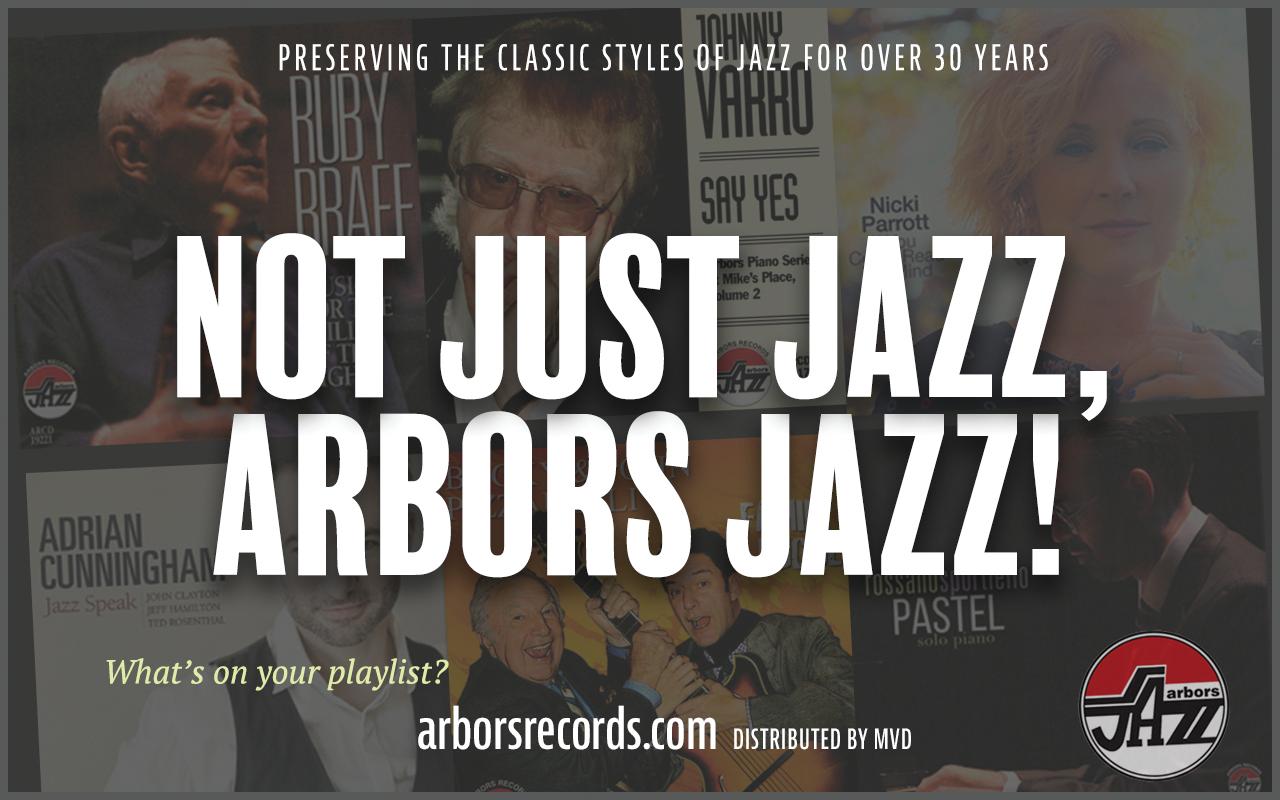
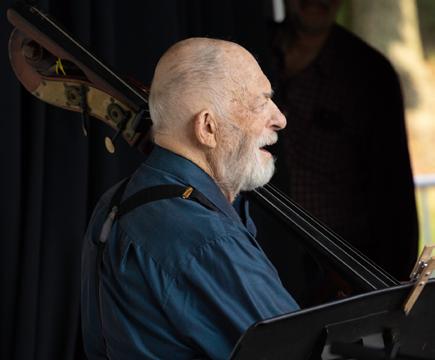
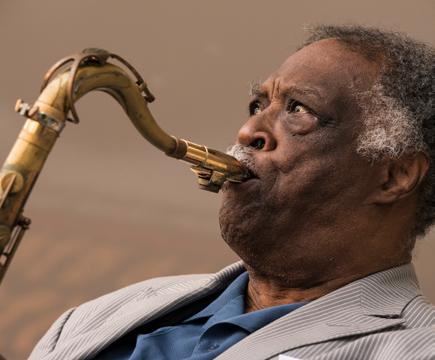
Fifty years ago, two New Jersey jazz fans, Bill Cleland and Jack Stine, founded the New Jersey Jazz Society. Cleland was an avid jazz fan, but the driving force was Stine, and, if not for his leadership, NJJS would probably not have been created.
Despite the fact that Stine wasn’t a musician, veteran cornetist Ed Polcer would refer to him as “The Bandleader”. “We were a happy bunch of souls with one thought in mind,” Polcer told Jersey Jazz shortly after Stine’s death at the age of 96 in June 2018. “There were doctors, teachers, lawyers, an ice cream truck route man, a mechanical engineer, and a liquor store owner.” It was the liquor store owner, Jack Stine, who molded the group into an organization to promote live jazz.
BY SANFORD JOSEPHSON
Prior to the founding of NJJS, New Jersey jazz fans would meet at the Chester Inn to hear drummer Chuck Slate’s Traditional Jazz
13 OCTOBER 2022 JERSEY JAZZ NJJS.ORG
50TH ANNIVERSARY
NJJS
Honoring Two Living Legends – Bassist Bill Crow and Tenor Saxophonist Houston Person “NJJS Members Would Turn Up to Hear Jimmy Andrews at O’Connor’s Beef and Ale House in Watchung or Chuck Slate at the Widow Brown’s in Madison”
CROW PHOTO BY ALLISON BROWN; PERSON PHOTO
BY JOHN HESTER
Bill Crow Houston Person
Band or at the Hillside Lounge (also in Chester) to see cornetist Wild Bill Davison or guitarist Al Casey, who had played with Fats Waller. The New York Times’ John S. Wilson visited those jazz rooms in 1972 and wrote, “If there is such a thing as a ‘jazz center’ in New Jersey, it must be here.”
The New Jersey Jazz Society was organized in October 1972. According to a December 1,1974, article by The New York Times’ Ray Warner, “the NJJS members would turn up to hear pianist Jimmy Andrews at O’Connor’s Beef and Ale House in Watchung or Chuck Slate at the Widow Brown’s in Madison, or perhaps Bucky Pizzarelli on Monday (guitar night) at Gulliver’s in West Paterson. These are among the half dozen or so Jersey places regularly presenting small jazz groups these days.”
Al Kuehn, Producer of the annual

Chicken Fat Ball in Maplewood, remembers the first big NJJS concert, at Fairleigh Dickinson University on September 30, 1973. “Dick Wellstood, Don Ewell, and John Eaton all played, and Eubie Blake showed up,” he recalled. “I was the youngest guy there, so I’m still a survivor.”
Fifty years later, to commemorate its founding, NJJS is honoring
When tenor saxophonist
Don Braden first heard Houston Person, he said, ‘I want to sound like that one.’
two living legends—94-year-old bassist Bill Crow and 87-year-old tenor saxophonist Houston Person.
Throughout his career, which began in the 1950s, Crow has played and recorded with a long list of jazz legends including Bob Brookmeyer, Benny Goodman, Marian McPartland, Gerry Mulligan, and Clark Terry, among many, many others.
When he joined the Army in 1946, Crow played baritone horn, valve trombone, and trap drums in the 51st Army Band at Fort Lewis, WA. In January 1950, he moved to New York City. In the summer of 1950, he was hired as a trombonist for a job in the Adirondacks and was talked into learning to play the string bass. “By the time the summer was over,” he said, “I could play the bass well enough to take gigs in New York City, and every gig was another lesson.” He remembers when he started playing professionally and would attend a jam session. “I didn’t own a bass,” he said, “so, I would wait until the bass player was tired. Then, I would borrow his. The bass player would get tired because there was one bassist and 10 saxophonists.”
Crow loves to reminisce about his years with McPartland at 52nd Street’s Hickory House, recalling
14 OCTOBER 2022 JERSEY JAZZ NJJS.ORG
NJJS 50TH ANNIVERSARY
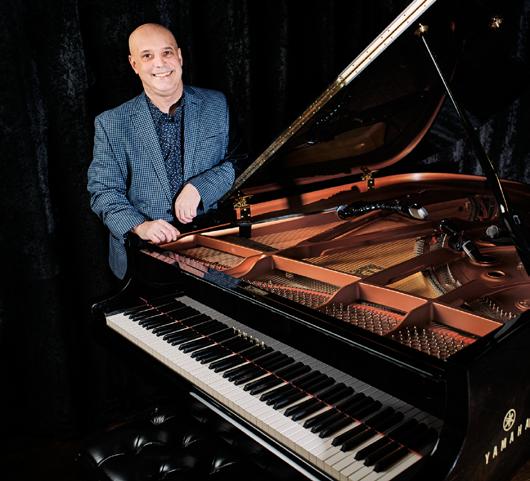
that Duke Ellington used to hang out there. “Marian used to coax him to come up and play with us once in awhile,” he said. “I stayed with Marian and (drummer) Joe Morello for about 2 ½ years. I left because Gerry Mulligan wanted me to play with his sextet, and I couldn’t turn that down. That lasted for about a year, and then I went back with Marian. By that time, Joe had gone with Brubeck, so Dick Scott was the drummer. I was there another year, I guess. We used to take off from the Hickory House in the summertime and do a couple of out-of-town gigs at Baker’s Keyboard Lounge in Detroit, and then in Columbus, Ohio, at a place called the Grandview Inn. Then, I got busy with Gerry again.”
Crow became a part of Gerry Mulligan’s Concert Jazz Band in the early ‘60s, joining the band when “it couldn’t have been hot-
ter. It was at its peak. With Clark (Terry) in the trumpet section and (Bob) Brookmeyer in the trombone section, and Gerry in the saxophone section, we could open up every chart we wanted to. And, if somebody was playing a good solo, Gerry would go into quartet mode. It was really great. I loved that band.”
Carl Maraghi, a baritone saxophonist influenced by Mulligan, played with Crow at Dizzy’s Club in January 2020. “In every set,” Maraghi said, “I made sure Bill had a few minutes to tell a story. This man is a treasure to our community, the jazz world, and beyond.”
Crow currently plays with young keyboardist Leonieke Scheuble and her drummer father Nick Scheuble in the Generations of Jazz Trio. When the trio was featured in the June 2021 issue of Jersey Jazz, Leonieke said, “What
15 OCTOBER 2022 JERSEY JAZZ NJJS.ORG NJJS 50TH ANNIVERSARY
Pianist Larry Fuller was in high school when he first heard Houston Person live in Detroit.
PHOTO BY ROB DAVIDSON
I love most about playing with Bill Crow is that it’s 50 per cent playing and 50 per cent stories. He told me about playing with Stan Getz when the string on his bass broke, so he took one from under the piano.”
As a young man serving in the Air Force in Germany, Person played on weekends with members of the Seventh Army Band—trumpeter
Don Ellis, fellow tenor saxophonist Eddie Harris, pianist Cedar Walton and multi-reedist Leo Wright. After leaving the service, he studied jazz at the University of Hart-
ford’s Hartt College of Music.
In 1968, Person teamed up with vocalist Etta Jones for a partnership that lasted more than 30 years until Jones’ death in 2001. “Those were great years for both of us,” he said. “I’d always dreamed of having a band with a vocalist. When we got together, it just worked for us. It was a lot of fun.”
Bassist Matthew Parrish, currently a member of Person’s regular quartet, was a big fan of Person and Jones in the 1980s when they hosted Brunch at the Blue Note. “I

Baritone saxophonist Carl Maraghi played with Bill Crow at Dizzy’s Club in January 2020.
“ HOUSTON’S TONE IS
VERY INSPIRING–HIS SOULFULNESS AS A PLAYER, HIS POSITIVE ENERGY. ”
used to go see them all the time,” he said. “For me,” he added, “Houston is probably the greatest vocal accompanist alive. And, that translates to when he doesn’t have a vocalist. He becomes the vocalist. That’s what’s so beautiful about his playing. What’s so special about it.”
Parrish recently recorded a new album (so far, unnamed) with Person, pianist Larry Fuller, drummer Lewis Nash, and guitarist Russell Malone.
Fuller has played with Person “many times over the years. I believe the first time I heard him live I was in high school, and he played at a club called Dummy George’s in Detroit with his group featuring the great Etta Jones. This would’ve been in 1983, and I was knocked out to hear his huge sound in person and his incredible soulfulness and command of the blues, which came through in everything he played. Houston,” Fuller continued, “collects original sheet music of standards and American Songbook tunes, and he told me he learns the lyrics to every tune he plays.”
Tenor saxophonist/flutist Don Braden admires Person “because of his saxophone tone. The first time I heard him live, in Paris in the ‘90s, I thought, ‘I want a sound like that one.’ So, the next time I went to London, I bought a Lawton mouthpiece, the same brand that he plays. I played it for many years. Houston’s tone is
16 OCTOBER 2022 JERSEY JAZZ NJJS.ORG
NJJS 50TH ANNIVERSARY
“ ILLINOIS JACQUET WAS MY INITIAL INFLUENCE. AND LESTER YOUNG. ”

very inspiring—his soulfulness as a player, his positive energy. And, he usually has a smile on his face.”
In addition to Parrish, Person’s regular quartet members are pianist Lafayette Harris and drummer Vince Ector. However, “I get a lot of calls from a lot of people wanting me to play with them,” Person said, “and I do it because I want to stay active and have fun with the music. I want to keep up with what everybody else is doing.” Person’s sound is often compared to that of Ben Webster and Gene Ammons, but he said, “Illinois Jacquet was my initial influence. And Lester Young.”
Person lived briefly in Nyack, NY, and during that period he played some gigs with Crow, who lives in New City. “There was a trumpet player named Fred Smith who lived up in Peekskill,” Crow recalled, “and we did some concerts that Houston played in. Then, Houston called me up and hired me for a couple of gigs.” Said Person: “I would like to congratulate Bill Crow. He helped me a lot and was always there when I lived in Nyack. His humor is keeping us laughing. I’m glad that you all are recognizing him, and I thank the New Jersey Jazz Society for letting me smell a few of the roses before I leave here.”
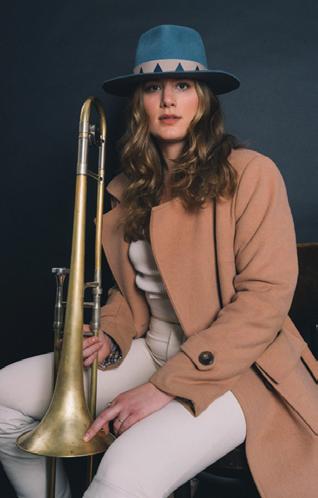
NJJS.ORG 17 OCTOBER 2022 JERSEY JAZZ NJJS 50TH ANNIVERSARY
For the complete performance schedule, visit grunincenter.org. Grunin Center Box Office Hours Monday-Friday 12:00pm-5:00pm 732-255-0500 College Drive P Toms River, NJ Contact the Box Office four weeks prior to any show to arrange for disability and accessibility services. MARIEL BILDSTEN Sunday November 20 • 3:00pm






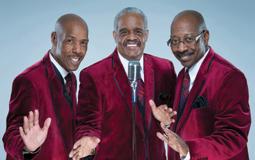


Buy Tickets Today! SOPACnow.org/Jazz (973) 313-2787 Bettye LaVette & RauL Midón FRI, OCT 7 AT 8PM Tickets: $42-$59 Lucky Chops new day, new tour SAT, JAN 28 AT 8PM Tickets: $26-$35 Russell thompkins Jr. & the new Stylistics FRI, JAN 20 AT 8PM Tickets: $65-$85 Visit SOPACnow.org/ Covid-19 for all Covid-19 Precautions & Policies Giants of Jazz 23 Honoring Rufus Reid Produced by John Lee SAT, NOV 19 AT 8PM Tickets: $55-$65 Hot Sardines Holiday Stomp THU, DEC 1 AT 7:30PM Tickets: $40-$50 ain’t no Mountain High enough! Valerie Simpson and Friends Sing ashford & Simpson FRI, NOV 11 AT 8PM Tickets: $58-$88 Scan for more upcoming events! SOPaC programs are supported in part by a grant from the new Jersey department of State, division of travel and tourism.

A Jersey Jazz Interview with Marty Grosz
BY SCHAEN FOX
Ninety-two-year-old guitarist/banjoist Marty Grosz made his first recording in 1930 with a band that included the young pianist, Dick Wellstood, and veteran New Orleans bassist, Pops Foster. Since then, he has played with practically everyone in the world of traditional jazz. He was part of pianist Dick Hyman’s New York Jazz Repertory Orchestra, Bob Wilber and Kenny Davern’s Soprano Summit, Yank Lawson and Bob Haggart’s World’s Greatest Jazz Band, and the Classic Jazz Quartet with Wellstood, multi-reedist Joe Muranyi, and cornetist Dick Sudhalter. Schaen
Fox reminisces with Grosz about his life and career.
19 OCTOBER 2022 JERSEY JAZZ TALKING JAZZ
PHOTO BY LYNN REDMILE
JJ What do you remember about the early days of your career?
MG Jazz was actually dance music. In the 1930s there was no such thing as a jazz concert, until the Benny Goodman thing at Carnegie Hall in ’38, and a few events like that. It was for dancing. There was enough interest that every major city had a joint or two. Nick’s in the Village had some fine musicians—Bobby Hackett, Brad Gowans, and Eddie Condon. Fats Waller sat in on piano. Sidney Bechet had a trio there. It’s hard to imagine in a time of dire depression, they had an eightpiece band on the stand and when they’re off, a trio comes up and plays with Bechet. That represented jazz.
JJ You played at the White House with that New York Jazz Repertory Orchestra. What was that like?
MG That was a Louis Armstrong program with three trumpets: Pee

Wee Erwin, Joe Newman and Jimmy Maxwell, a rhythm section and a trombone, a clarinet, and the singer Carrie Smith. It was during Jimmy Carter’s time at the White House. The German Prime Minister had expressed a liking for American jazz, so we went. You don’t get paid if you play at the White House, which is okay. I would have paid to play there. They treated us very well. Jimmy Carter was very appreciative and shook our hands. He was a nice man.
I liked Jimmy Carter. I schlepped a guitar and a banjo, and I could have had those cases full of dynamite. Nobody checked anything. They fed us a nice meal downstairs, and every guy got a White House person assigned to keep him or her company.
A week later I got a photograph at home of me in the band. The only trouble was, Jimmy Maxwell was about six and a half feet tall. A huge guy. He was in front of me, so all you could see was the neck of my guitar. You don’t see me.
JJ You were also a featured artist at the Hoagy Carmichael Tribute at Carnegie Hall in 1979. Do you have any memories of that to share?
MG It was a big deal production. They had a lot of musicians: Dave McKenna, Vic Dickenson, Eddie Miller, Yank Lawson, Bobby Rosengarten, Max Morath, Bob Haggart, Kay Starr; and I’m forgetting a lot. I liked Kay Starr because she belted out a song and made it swing, and she was pleasant to work with.
I remember that Dave McKenna’s assignment was to play Hoagy Carmichael’s first piano solo on “Stardust” or “Washboard Blues”. I can’t remember, but McKenna had a hangover. His eyes were bloodshot, and he was not a particularly eager reader. He was slow, as was I. He had to do a solo somebody had transcribed off a record from 1927 or something. I felt for
20 OCTOBER 2022 JERSEY JAZZ NJJS.ORG
PHOTO BY LYNN REDMILE TALKING JAZZ
TALKING JAZZ
him, because that was in his drinking days. He was sweating up there all by himself playing this old-fashioned stilted Carmichael thing from 1927. Hoagy was sitting in the third row so he could see everything on stage, and in the middle of it he said, ‘That’s not half bad,’ a term of approbation.
JJ George Grosz, the great anti-Nazi Weimar Era artist was your father. How did he get your family out of Germany?
MG My father came over because he had a job waiting in New York. He would have taken it whether he had been declared an enemy of the state or not, because the German and French eggheads and artists and such, were nuts to see New York. New York had skyscrapers. They didn’t have that. They got a diet of what’s happening in America: the assembly lines, the movie stars of the Hollywood
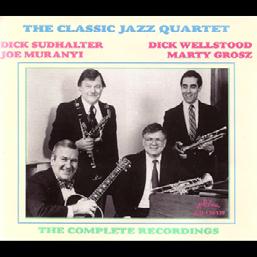
scene, and cowboys; the Germans were nuts about cowboys. They wanted to come over anyway. My father, since he had a job waiting for him, had no problem getting in. This was in January of ’33, and if you had a job waiting, you could come to America and stay. There was work for you, you weren’t going to go on the relief rolls. We lived in rented houses, in Queens County, sort of in the burbs. Most of
the emigres lived in New York City.
My father was declared an enemy of the state, which meant they take everything, your bank account, all that stuff. But he had outsmarted them. He had everything shipped to America: money, furniture, books, most important the paintings and art works. He beat them.
JJ I read that Artie Shaw once paid a visit to your family. Do you have any memories of that?
MG Artie Shaw always wanted to be an egghead. As my father said, ‘He’s read every book.’ He wanted to let you know that he was educated, and he was always spouting it. He couldn’t keep his trap shut. He came by one day in the winter. We lived in a rented house in Douglaston. We had been living in the house since 1937, and it’s now like 1943, and as you came in the front door, you were
greeted by a fireplace. We had never used it. So, my old man decided to build a fire in the fireplace. What he didn’t know was that things tend to accumulate in the chimney, animals, leaves, sticks, God knows what. He got some logs from someplace and kindling and started this fire. The whole chimney backed up and the house was full of smoke. So, here we are, it’s freezing because every window in the house was open, and I’m helping waving towels and such trying to get the smoke out of the house. That is when Shaw arrived with this very pretty, buxom Kathleen Winsor, author of a best seller, what they call a bodice ripper, Forever Amber. He was big time in those days. I remember I got Shaw’s autograph on a matchbook cover. That is all I could find that he could sign. On Monday, I took it to school, and they thought I was lying.
21 OCTOBER 2022 JERSEY JAZZ NJJS.ORG
JJ I’d like to get your memories of other musicians you knew, starting with Tal Farlow. MG I met Tal Farlow in 1947-48, in Southampton on Long Island. Four of us had talked a Greek diner boss into hiring us to play music for room and board; just out of high school. They put a couple of cots in an old bookie’s parlor, and our pay was free meals at the diner. We just wanted to play. I don’t think it even lasted two weeks. One evening I’m walking down the main street and there was
a club that had society music, and Tal was playing with it. I see this guy in a tux, with these big long hands resting on his knees, sitting on the curb. I said, “Excuse me for being nosy, but you look like a musician. Am I right?” He said, “You’re right.” He was working with this trio and it was just before he started building his reputation working with Red Norvo.
Later on, I ran into Tal at a couple of jazz parties on the West Coast. He was again playing with Red Norvo. We played the Concord California
“
WEE (RUSSELL) IS ONE OF THE GREATEST MUSICIANS I EVER HEARD. ”
festival, and they were all there—Tal Farlow, Barney Kessel, Herb Ellis, Charlie Byrd, everybody. I was working with Soprano Summit with Wilber and Davern. Afterwards, we went to Carl Jefferson’s house, the guy who had put on the festival. I wound up in a big room with a bar. Everybody else went someplace else. Tal Farlow came in and we started talking. I told him I remembered our first meeting, and he remembered it quite well. Then, because I play a different kind of tuning than most guys, he started telling me about alternate tuning. His mind was like a computer. It was unbelievable. He’d say, “Now if you take your E string, and tune it down to D. Now you take your next string B and tune it up to C.” And he went all over figuring it out in his head. He left me behind after three changes of tuning. I was having trouble keeping up. He was a very pleasant man.
JJ What about George Duvivier? MG George was a nice guy, sociable and friendly. I liked George. He did very well. He played in the studios.. He wrote arrangements, and was an excellent bass player. He was like the Boy Scout that got all the merit badges. He knew everything about everything, I mean technically. He was an intelligent and interesting person. We were playing in Toronto, and I ran into George waiting on the subway platform. He was timing between when one subway train would leave and the next would come. He would time elevator rides, technical stuff. He loved to drive, and he always had a new Cadillac.
He had studied violin, and was the concert master of the Harlem Youth Symphony at age 17 or 18. He told me that when he heard Coleman Hawkins’ record of “Body and Soul” he decided he wanted to play bass. He wrote a letter to Coleman Hawkins
22 OCTOBER 2022 JERSEY JAZZ NJJS.ORG
TALKING JAZZ
PEE

who lived in Harlem, too. One day he got a phone call from Hawkins. Hawk said to him, “You play bass huh? Why don’t you bring your bass over, and we can see what you can do?” He schlepped his bass six or seven blocks over to Hawkins’ house. Hawkins sat at the piano and played something, and Duvivier accompanied him. He said, “A week later, I was playing with Coleman Hawkins at Kelly’s Stable. One of my dreams had come true.”
JJ And Maxine Sullivan?
MG As a vocalist, I liked her, and as person, she was very nice and unpretentious. She was working as a nurse, her singing career was over, in the sense of making money with it. She was very easy to work with and very pleasant. I did a jazz party with her, and she had a pile of music. So, she gets up there and she puts the music on the piano. Dick Wellstood was playing piano, so he was sort of in charge of her segment. She just asked, “What’s the next tune?” He had the stack of music paper, and would say ‘So and so.’ “Okay.” And that was how the set went, no vanity. Vocalists can be a pain.
JJ And Pee Wee Russell?
MG Pee Wee is one of the greatest musicians I ever heard, in person or on record. As Louis Prima said, “Pee Wee Russell was a musical genius. There is nothing I could play, that Pee Wee couldn’t find a harmony to instant-
The Mark Clemente Chord MelodiesTM for Guitar
Playable, performance-ready arrangements for solo jazz guitar.
Each song is written in notation, tablature, and with chord diagrams. Choose from nearly 50 standards, which are included in two songbooks and available individually.
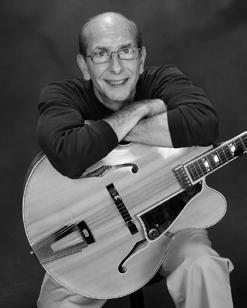
Praise from players at all levels ...
“Lots of guitarists who do weddings would benefit from your arrangements. I’ve learned Fly Me To The Moon , and I’ll be playing it at my next gig. Keep arranging, Mark. We need you.”
—MW, THEWEDDINGMUSICIAN.COM
“Mark, I enjoyed your arrangement of My Romance very much. I teach guitar and am always searching for chord melody pieces that are a bit challenging but ‘doable’ by intermediate players. Keep up the great work!”
—GB, MASSACHUSETTS
“I’m so happy with your arrangements! As a beginner, they are accessible even to me and are excellent studies of chord movement. Can’t thank you enough for these excellent arrangements!”
—DL, KENTUCKY
NJJS.ORG 23 OCTOBER 2022 JERSEY JAZZ
TALKING JAZZ
MarkClementeGuitar.com 201.444.9830
WAS NO TUNE THAT EDDIE CONDON DIDN’T KNOW.
ly.” I asked Bud Freeman, and he said, “They’ll be talking about Pee Wee 100 years from now.” I hope so. People made fun of him because he was awkward looking and “Pee Wee” was, because he was tall. He was an alcoholic, but he was something else. Few guys had the ear he had for never stepping on another person’s part and for improvising anything.
I’ll say something similar, although not as creative, about Eddie Condon. There was no tune that Eddie Condon didn’t know. There’s a bit of hyperbole there, but there was no tune that he couldn’t pick up in a moment or two, a fantastic ear.
JJ Do you have any special memories of playing in New Jersey?
MG I did play a lot for the New Jersey Jazz Society at Waterloo Village, and I played with a guy named
Parke Frankenfield (trombonist) and a lot with Dick Meldonian. We used to play one night a week in Hoboken at the Hoboken House. At first it was a quartet with different bass players. One was Jack Six. We had a following, but then real estate took over. I remember seeing a building with a doorman. I said, “What? Hoboken has a doorman? It’s the beginning of the end.” And it was, of the Hoboken that I knew. All of a sudden, the real estate people came in, and it got to be a chic place to live.
Waterloo was an event. It was jazz, with all kinds of things. Dick Hyman had about six pianos, maybe four, and he had a set where they all played at once. You ran into other musicians that you usually wouldn’t run into, and you had some fun. I remember talking to Dizzy Gillespie. What he was doing at Waterloo Village, I don’t know.

NJJS.ORG 24 OCTOBER 2022 JERSEY JAZZ TALKING JAZZ
THERE
JAZZPROMOSERV ICES.COM WE GET THE WORD OUT J i m E i g o J a z z P r o m o S e r v i c e s 2 7 2 S t a t e R o u t e 9 4 S o u t h # 1 Wa r w i c k , N Y 1 0 9 9 0 O f f i c e : 8 4 5 - 9 8 6 - 1 6 7 7 C e l l / Te x t : 9 1 7 - 7 5 5 - 8 9 6 0 S ky p e : j a z z p r o m o j i m @ j a z z p r o m o s e r v i c e s . c o m S P E C I A L I Z I N G I N M E D I A C A M PA I G N S F O R A RT I S T S , L A B E L S , V E N U E S A N D E V E N T S • NEW RELEASES • IMPORTANT ANNOUNCEMENTS • UPCOMING PERFORMANCES AND TOURS • E-MAIL MARKETING • PRESS CAMPAIGNS
RADIO MAILINGS eigo_jps_4.5x9ad_newjerseyjazzsociety_february2022_Layout 1 1/25/22 5:23 PM Page 1
“
”
•
Bela Fleck Continues to Push the Banjo’s Musical Boundaries
“There’s An Album I Did with Chick Corea Before He Passed That Will Be Coming Out in the Next Year.”
BY JAY SWEET
For years Bela Fleck has been pushing the boundaries regarding the traditional role of the banjo while also continuing to honor the roots of the music associated with that instrument. Not only is Fleck the most celebrated living banjo virtuoso, but he is also a true music historian who is particularly fascinated with any topic associated with the banjo. He even went so far as to showcase his love for the instrument’s history by tracing its African roots in his award-winning film
Bela Fleck: Throw Down Your Heart.
In the documentary, Fleck travels throughout Africa, where he learns and performs with local musicians.
Fleck, who will be appearing with his wife, banjoist and vocalist Abigail Washburn, in West Long Branch and South Orange, NJ, this month, was born in New York City on July 10, 1958. Many city kids growing up in the 1960s and ‘70s were heavily influenced by rock music, particularly the music of the Beatles, Rolling Stones, and other British and American stars. For Fleck, however, his most significant early in-

25 OCTOBER 2022 JERSEY JAZZ NJJS.ORG JAZZ AT THE POLLAK AND SOPAC
Bela Fleck (left) and Chick Corea
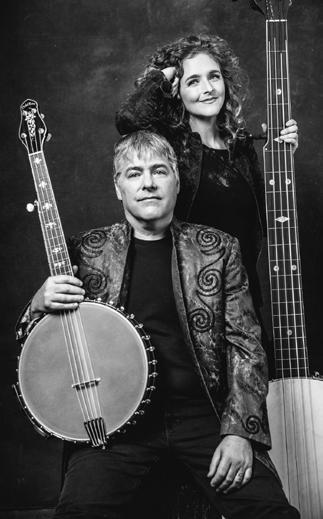
fluence was bluegrass banjo master Earl Scruggs. In an email interview, Fleck explained why. “I heard Earl Scruggs play the banjo on the Beverly Hillbillies theme,” he said, “and it blew my mind. I must’ve been four or five years old. Earl had that power over people that were going to be banjo players. Once they heard him, their lives were forever changed.”
During his youth, Fleck studied banjo with private instructors, and in addition to his admiration for bluegrass, he also began to study jazz. “I suppose (my interest in jazz) has to do with growing up in New York. I heard jazz in the city as a kid and became extremely interested in Charlie Parker‘s music and later Chick Corea‘s music. They both seemed a bit more possible to achieve on the banjo because they had a lot of rhythmic qualities.”
located to Boston, where he joined and recorded with the bluegrass unit Tasty Licks. He then made his solo recording debut, Crossing the Tracks (Rounder Records), in 1979 and began touring with the band, Spectrum. In 1981, Fleck joined the highly influential experimental bluegrass unit New Grass Revival. The group then included mandolinist Sam Bush (founding member), guitarist Pat Fynn, and bassist John Cowan. The group was widely responsible for popularizing the newgrass movement, which blended rock and jazz music with traditional bluegrass. Fleck remained with the band until 1989.
brother Roy “Futureman” Wooten, who often played his invention of a handheld electric percussion instrument called the“drumitar.” Past members included harmonica player and keyboardist Howard Levy and, later, saxophonist Jeff Coffin. The Flecktones have released 10 acclaimed studio albums, many of which found favor with jazz fans and the jam band community.
When asked how he came to use the banjo in more experimental roles, Fleck revealed, “ I think it was because I grew up in New York City in the ‘60s; it was a very fruitful time for music of all types, and I was influenced by all the music I heard around me. So, when I played the banjo I thought I was supposed to be creative and do new things with it.”
In addition to his desire for experimentation and showcasing the banjo in non-traditional roles, Fleck never abandoned acoustic music and continued collaborating with some of Bela
After graduating from New York’s High School of Music and Art, Fleck re-
In 1988, Fleck formed and played electric banjo in his most well-known group, Bela Fleck and the Flecktones. For nearly two decades, the group offered a blend of instrumental jazz, bluegrass, rock, and world music with an eclectic lineup that included electric bass master Victor Wooten and his
26 OCTOBER 2022 JERSEY JAZZ NJJS.ORG JAZZ AT THE POLLAK AND SOPAC
Fleck and Abigail Washburn
the most gifted musicians of our time. Some of his more remarkable acoustic projects include his work with the group Strength in Numbers, an album series called Tales From an Acoustic Planet (Warner Brothers), and various recordings with collaborators such as Edgar Meyer, Zakir Hussain, Jerry Douglas, Doc Watson, The Colorado Symphony Orchestra, and most recently with his wife, Abigail Washburn. Additionally, Fleck has worked and recorded with such jazz stars as Chick Corea, McCoy Tyner, Charlie Haden, and Mike Stern. Fleck has also been called upon to record with stadium acts, such as Phish, Dave Mathews Band, and the Zac Brown Band. His discography currently includes more than 300 recordings, and his versatility is remarkable. When asked how he can master so many genres, Fleck said, “(I) listen to the music a lot. If you do that, you have a fighting chance of fitting
in because you know how the music is supposed to sound. I also appear to have a pretty intense work ethic, and I love practicing and my time by myself playing the banjo. I tell students that if they don’t learn to love practicing, they’re not gonna get too far.”
After being shut down for some time due to Covid restrictions, Fleck is back touring. “I’m fortunate enough to be able to tour in several different contexts,” he explained. Lately, I’ve
been playing with my Bluegrass Heart (Renew Records: 2021) project, which is an all-star group of instrumentalists that come from the Bluegrass virtuosic community. In the last 10 years, I’ve also been playing with my very talented wife, Abigail, who is a clawhammer banjo player and a wonderful singer. It’s a very different way to tour after a lifetime of being on the tour bus with a band and crew. This time it’s all about the family. We bring

our two kids along on the tour bus, and we play the music we’ve crafted together using the two banjo styles and Abby‘s vocals to get creative. It’s been a long time since we’ve toured as a duo, and I’m really looking forward to it.”
When asked about the future of the American instrumental music tradition, Fleck feels like “the good news is there are a lot of young folks playing traditional music and instrumental music at all times. That’s what we need for the music to move forward. These are very special kinds of music because they’re not in the mainstream, and luckily, there’s a lot of talent out there and a lot of interest. The hardest part is actually making a living doing jazz or bluegrass. So I think the ongoing challenge is how to reach an audience with music that is not in the mainstream.”
In regard to jazz specifically, Fleck said, “I believe the trick here
27 OCTOBER 2022 JERSEY JAZZ NJJS.ORG
JAZZ AT THE POLLAK AND SOPAC
is going to be the musicians finding an audience. There are a lot of great players out there in the jazz world and not enough places for them to play, so finding a way to make the music communicate to folks out there is very important; and it’s not easy because it’s not a mainstream pursuit. It is a wonderful way to spend a life as a musician if you can figure out how to play the music you love.”
Regarding upcoming and possible projects: “There are several projects in the works. One is an album Abigail and I made during the pandemic called Banjo House Lockdown. Another fun project is with my old friends, Edgar Meyer, Zakir Hussein, and Rakesh Chaurasia. This project delves into Indian music and its connections to bluegrass and classical music. Additionally, there’s an album I did with Chick Corea before he passed that will be coming out in the next year.”
Fleck believes “there’s so much out there that would be worth learning on the banjo. Fortunately, there are a lot of young players coming along doing great things and exploring areas that I have not. I look forward to seeing what comes next in the banjo world. But I still have a few tricks up my sleeve.”
Bela Fleck and Abigail Washburn will perform at the Pollak Theater (Monmouth University) in West Long Branch on October 15 and the South Orange Performing Arts Center on October 26. “For some reason, New Jersey has always been a great place to tour,” he said. The audiences are very receptive to music, and I’ve heard this from many groups. So we always look forward to returning to New Jersey.”
: To order tickets, go to mpv. tickets.com for The Pollak Theatre and sopacnow.org for the South Orange Performing Arts Center.
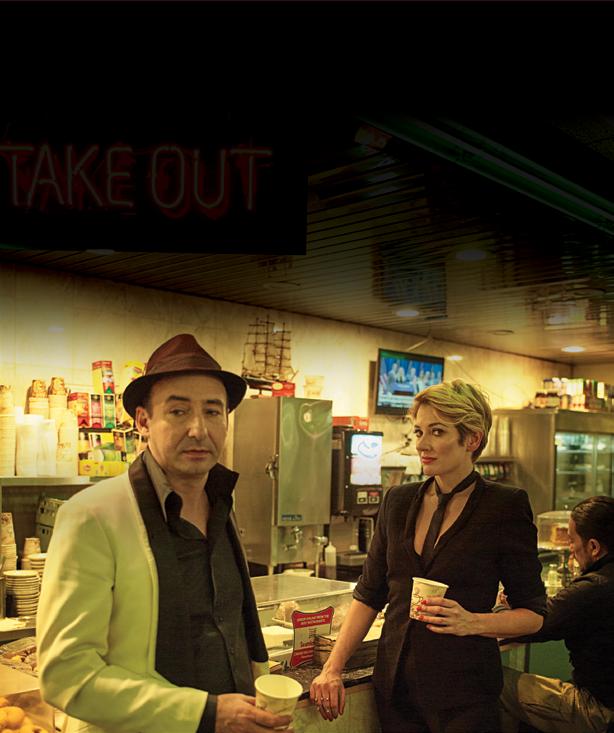
Friday, November 11, 2022 at 8:00PM
The Hot Sardines
Fueled by the belief that classic jazz feeds the heart and soul, The Hot Sardines are on a mission to make old sounds new again and prove that joyful music can bring people together in a disconnected world.
“Potent and assured.”
To learn more visit
mccarter.org/hotsardines


NJJS.ORG 28 OCTOBER 2022 JERSEY JAZZ
JAZZ AT THE POLLAK AND SOPAC
Trumpeter/Pianist Alvaro Caravaca: ‘Hungry to Learn, an Incredibly Bright Future’
Nathan Eklund is “My Rock. He’s Going to Get Me the Proper Things That I Need to Get Me Where I Need to Go.”
BY SANFORD JOSEPHSON

When Alvaro Caravaca was three or four years old, he played classical pieces he heard on the demo for his piano. “I didn’t even know what the word transcription was,” he said, “but I’d been doing it.” Then, “I was just playing random music and, somewhere, somehow, I heard the album, Time Out, by Dave Brubeck,” and that introduced him to jazz.
Caravaca, currently a senior at Mount Olive High School, began playing the trumpet, in addition to piano, in the fourth grade. “I was supposed to play trombone,” he said. “My grandmother really wanted me to play trombone. The way it worked was all the students got together in the elementary school cafeteria, and they had a bunch of professional musicians come
in, each really, really good at their specific instrument. I was seated in the very front, and there was this one trumpet player, and he kept looking at me. Then, he came up to me and asked, ‘Would you like to hold this instrument?’ I picked it up and started clicking the buttons. This was really cool. It was really fun to press the valves. So, I picked the trumpet instead.”
In middle school, two teachers – Middle School Band Directors Melany McQueeny and Kenneth Adessa – “introduced me to other forms of jazz.” When Caravaca was in eighth grade, McQueeny, who is now Department Chair for Music, nominated him for the Music Student of the Month program at Morristown’s Mayo Performing Arts Center, and
29 OCTOBER 2022 JERSEY JAZZ NJJS.ORG
RISING STAR
Caravaca on trumpet at Jersey Jazz Live!
PHOTO BY MITCHELL SEIDEL
RISING STAR

he was named Mayo’s Outstanding Jazz Musician in December 2018. “She’s always been supportive of me,” he said. “She found this opportunity at MPAC, and she ended up putting my name in, and, lo and behold, I got chosen. That entailed a performance at MPAC, and then I got to meet (saxophonist) Dave Koz, and then I got a little band together.”
“Alvaro,” McQueeny said, “impressed me with his talent and work ethic at a young age. He was involved in as many programs as he could be when it came to music. When I introduced the concept of improvisation in the middle school jazz band, I asked if anyone was willing to give it a try. Without hesitation, Alvaro, then in the sixth grade, raised his hand and said with a smile, ‘I’ll try.’ The natural ability he showed with such an advanced skill left a lasting impression on me to this day.”
Adessa gave Caravaca “access to great music, great recordings, and great jazz artists. Recognizing his deep love and his expression in the jazz art form prompted me to get Alvaro involved with (educator/saxophonist) Julius Tolentino, first at Jazz House Kids and then at NJYS (New Jersey Youth Symphony Jazz). Tolentino “could hear early on in Alvaro’s sound and playing that he had a special connection with music. Like all of my students, I point them in the direction of learning jazz music as a language.”
Last November, Caravaca had an opportunity to play with Wynton Marsalis, who was giving a brass master class at the beginning of a three-day residency at Montclair State’s John J. Cali School of Music. “I didn’t even know about this until about a week before,” Caravaca said. “I just remember (tenor saxo-
30 OCTOBER 2022 JERSEY JAZZ
At Jersey Jazz
Live!, Caravaca on piano with alto saxophonist Ginger Meyer.
PHOTO BY MITCHELL SEIDEL
RISING STAR
phonist) Mike Lee and Helen ChaPyo (Artistic Director and Principal Conductor, Wharton Institute for the Performing Arts) saying, ‘You’re going to play with someone.’ So, I thought ‘If I’m going to do something hard, I should pick something difficult.’” He chose Benny Golson’s “Stablemates”, and he traded fours with Marsalis, who told him, “I love what you did. That was unbelievably soulful.”
The 17-year-old Caravaca plans to pursue a career in music and is thinking about applying to the
Manhattan School of Music where trumpeter Ingrid Jensen was recently named Jazz Dean (See interview with Jensen on page?). “I just remember taking a master class with Ingrid Jensen,” he said. “She inspired me so much, so I really want to learn from her.” He added that he will also apply to some other schools around the New York area.
This past spring, Caravaca was part of the Jazz House Kids Big Band that was a finalist in Jazz at Lincoln Center’s Essentially Ellington com-
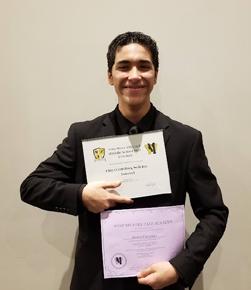
While in Middle School, Caravaca was named Outstanding Soloist and received a scholarship to West Milford Jazz Academy.
petition like this,” he continued. “Hard work, optimism, and leadership. All those things encapsulated in every single person invariably lifts you. It was really inspiring.”
“
ONE OF THOSE STUDENTS WHO HAS EMBODIED THE LANGUAGE AND CULTURE OF JAZZ. ”
petition. “My first experience with that,” he said, “was being put in a room where they mixed up all the bands together for a dinner. I remember sitting next to a trumpet player, Nathaniel Williford (Williford is a junior at Osceola County School for the Arts in Kissimmee, FL). “Man, let me tell you, he was the most humble guy I ever met. I could not even tell he was going to be one of the greatest trumpet players I heard at my age.
“There’s a certain vibe to every person who gets into a com-
The Coordinator of the Big Band program at Jazz House Kids is trumpeter Nathan Eklund, who Caravaca describes as “my rock. I met him through Mr. T (Tolentino). From Julius Tolentino to Nathan Eklund to Mike Lee. He’s going to get me the proper things that I need to get me where I need to go. He’s leading me to the doors, providing me with the necessary tools to walk through them.”
Eklund describes Caravaca as “one of those students who, at an early age, has embodied the language and culture of jazz. He’s hungry to learn, and his work ethic keeps him steadily processing. As an educator, these are the types of students you want to work with, as they are will-
31 OCTOBER 2022 JERSEY JAZZ NJJS.ORG
“ I TRY TO IMMERSE MYSELF WITH ALL FORMS OF MUSIC. ”
ing to put in the hard work. Your job is just to keep directing them where they want to go. I see an incredibly bright future ahead for Alvaro and feel lucky to be part of the journey!”
At the New Jersey Jazz Society’s Jersey Jazz Live! concert on August 28 at the Madison Community Arts Center, Caravaca led the opening act, which included alto saxophonist Ginger Meyer, bassist Sam Konin, and drummer Mecadon McCune. As they played modern jazz tunes such as Charles Mingus’ “Peggy’s Blue Skylight”, Thelonius Monk’s “Ruby
My Dear”, and Tadd Dameron’s “Ladybird”, it was clear that the future of jazz is in good hands. “I try to immerse myself with all forms of the music at all times,” Caravaca added. “I don’t have a favorite genre.”
And, he is grateful to his family for supporting him and exposing him to music at an early age. “My dad played guitar,” he said, “but he’s a scientist, and my mom was a teacher for the longest time. I remember there was always Latin music playing in the background for my mom, and my dad always loved to play rock music.”

NJJS.ORG 32 SEPTEMBER 2022 JERSEY JAZZ
RISING STAR
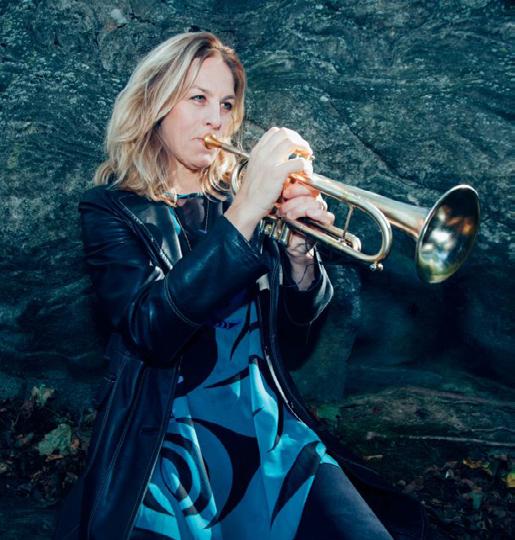
Ingrid Jensen Takes the Jazz Reins at Manhattan School of Music
“A Student Has to Have a Level of Trust with the Instructor to Make a Connection That Creates Inspiration.”
BY JAY SWEET
The Manhattan School of Music Jazz Arts program is one of the finest jazz institutions in the world. Some notable alumni include legendary jazz figures such as Donald Byrd, Herbie Hancock, Harry Connick Jr., Chris Potter, Max Roach, and Phil Woods. Ingrid Jensen, a noted trumpeter and educator from Canada, has recently been appointed Jazz Dean. Jensen has worked and recorded as a leader and with a multi-generational cast of notable musicians including Clark Terry, Esperanza
Spalding, and Maria Schneider. She is also a member of pianist Renee Rosnes’ all-female sextet, Artemis.
Acknowledging that, “The Dean job just fell into my lap.” Jensen recalls that, “I was on a search committee to find a new Dean, and then Covid hit. I was then selected by the Provost and the President to jump in and try out the job. So I had a two-year audition, and this is my first official year as Dean, and it’s very exciting.”
Jensen’s interest in jazz began at a very young age. “My mom was a
33 OCTOBER 2022 JERSEY JAZZ NJJS.ORG JAZZ EDUCATION
BY
PHOTO
MARIANA MERAZ
big Louis Armstrong and Jack Teagarden fan,” she recalled. “She was a great classical piano player who wanted to play piano for a living, but her parents told her that it wasn’t a real job, and she became a school teacher and wasn’t happy doing it — probably because she wanted to play the piano. After school, she would play the piano to relax. She would play Scott Joplin and Art Tatum transcriptions and old standards.
“We also had a great record collection. We had band programs in our school that were well supported by the community. It was a blue-collar paper mill town called Nanaimo. It was the same town that Diana Krall came from. We both went through these great music programs that supported jazz, and we played with big bands and dances. At first, I wanted to play trombone, but my older sister played the trombone; we didn’t like each other
when we were young, but we get along great now. So I played the trumpet because, according to my mom and band teacher, I was spunky, and my attitude would fit well with the trumpet.”
After high school, Jensen studied at Berklee College of Music and then recorded three acclaimed albums for the ENJA label. She soon became one of the most sought-after jazz trumpeters on the scene. In her early 20s, she moved to Europe, where she became the youngest professor in the history of the Bruckner Conservatory in Linz, Austria. In the mid-1990s, Jensen settled in New York and became heavily active on the jazz scene.
In addition to playing, Jensen continued to work as an educator and taught at such institutions as the University of Michigan, the Peabody Conservatory, and Purchase College before joining the faculty at MSM. When asked how the Manhattan School pro-

gram differs from others, Jensen explained, “The Manhattan School Jazz program is smaller than other similar programs, but it is large enough so that we can accommodate six different large ensembles that explore a bunch of interesting and challenging music. Everyone gets to play with combos, and we do lots of performances. What really makes us different is that we are in New York City, and, therefore, we have access to the most incredible faculty in the world because they live and work here.” The school’s current faculty includes jazz notables such as Ron Carter, Regina Carter, Jon Faddis, Vincent Herring, Frank Lacy, Bill Kirchner, Jim McNeeley, Steve Turre, and Buster Williams. Jensen detailed her approach to instructing students. “One of my main philosophies as an instructor is that a student has to have a level of trust with the instructor to make a
34 OCTOBER 2022 JERSEY JAZZ NJJS.ORG
EDUCATION
JAZZ
connection that creates inspiration. My philosophy is fluid. Every student has different strengths and weaknesses. I try to tap into all of that. I believe in mind-body integration in an attempt to eliminate stress, fear, and hang-ups. I try to offer an environment where my students can have the freedom to create and improvise. The idea is to help the student uncover who they are in relation to the tools they are gathering to make them a stronger person and player.
“The advice I have for young jazz students is to practice, practice, practice. Everyone says that, but what does that mean? For me, it’s more of
a meditative, focused, and integrated deep dive into the music, learning every aspect possible. With this particular music, I find it important for students to play together as soon as possible. They should meet other people with a common interest. This music is about connection; it’s social music; we are making it up at the moment based on a ton of theory and listening. Play as much as possible with as many people from as many different cultures as possible. Then you will develop a voice and a personality that is supported by what’s happening around you.
“Jazz is all about the present
moment, and thank goodness for that. It is moment-to-moment music. That’s why we work on our skills and technique so that we can create with ease in order to execute ideas in a way that is beautiful, flowing, fun, crazy, wild, and expressive. The present state of jazz, or Black American Music, as I prefer to call it, is super exciting because there is a deeper level of respect happening from the exposure happening through the internet and various platforms.”
While Jensen is passionate about educating, her excitement for performance has never waned. One of her most impressive projects comes
“ JAZZ IS ALL ABOUT THE PRESENT MOMENT, AND THANK GOODNESS FOR THAT. ”
as a band member in Artemis. In addition to Jensen and Rosnes, the group includes tenor saxophonist Nicole Glover, alto saxophonist Alexa Tarantino, bassist Noriko Ueda and drummer Allison Miller. The band recently played at the Montclair Jazz Festival on September 10 and is gearing up for upcoming performances in Seattle and Monterey. “Artemis,” she said, “is such a great group of incredible humans who happen to be women. We basically started by doing a concert and just loved playing together. There wasmagical energy, and we decided to continue the group. Rene Rosnes was just the brightest light of all as she started to shape and guide the group into being. We just did our second record for Blue Note and are very excited about it.” Jensen added that she has several other projects on the horizon as she continues to balance her teaching and performing.
35 OCTOBER 2022 JERSEY JAZZ NJJS.ORG JAZZ EDUCATION
FROM THE CROW’S NEST
BY BILL CROW
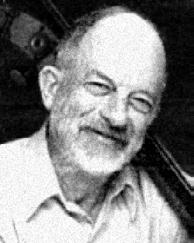
Here’s one that made its way around the theaters:
The orchestra for a Broadway show had just gone into the pit. The second viola player was still in the band room, changing a string, when the company manager rushed in and said, “The conductor just had a heart attack, and they’ve taken him to the hospital! The assistant conductor has already checked in and gone home. Does anyone else know how to conduct the show?” The viola player said, “Actually, I’ve watched some rehearsals, and I think I can do it.” She went into the pit and stood at the conductor’s podium. Sure enough, she knew the show well enough to get them through the performance without any train
Bill Crow is a freelance musician and writer. His books include Jazz Anecdotes, Jazz Anecdotes: Second Time Around, and From Birdland to Broadway. This column is reprinted with permission from Allegro , the monthly magazine of AFM Local 802.
wrecks, and she went home feeling satisfied that she had saved the show.
The next night, she took her usual place in the string section. The first violist looked at her and said, “Well, where were you last night?”
One of the last jobs that Al Cohn and Zoot Sims played together was at one of our favorite clubs, in Edgewater, NJ, called Struggles. I was happy to be in the rhythm section. When Al got on the bandstand, he handed me a little slip of paper on which he had written some chord changes. “I wrote a new bossa nova,” he said. There was no music stand there, so I Scotch-taped the slip of paper to the back of Zoot’s jacket. He was standing right in front of me, and the spotlight was lighting up his front, but his back was dark, and I couldn’t see the first chord very well. I saw the C7, but not the little m underneath,
and I played a major 3rd in my line by mistake. I heard that it was wrong, and I corrected it the next time around.
After the set, Al said to me, “Hey, you played a major third on the first chord of that bossa nova.” I said, “But I only did it once!” Al said, “Yeah, but after that, on every chorus, I worried!”
On Facebook, Chuck Erdahl told about a wedding guest who kept hounding the keyboard player to let him play. So, the keyboard player programmed some Aftertouch on his DX7 and let the guy sit in. As the band played “Johnny Be Good”, a wild boogie woogie with undulating pitch and dynamics poured out of the DX7, making the guy give up in about 20 seconds and cracking the band up.
Barry Nitikman told his Facebook group about an outdoor society gig at a private home in Montecito, CA, on a very chilly night. The caterer had provided heaters for the guest tables,
36 OCTOBER 2022 JERSEY JAZZ NJJS.ORG
FROM THE CROW’S NEST
BY BILL CROW
Keith Bishop told about a TV show he once played with Buddy Rich’s band. They accompanied guest artist Ray Charles. At the rehearsal, Ray wasn’t happy with the way the sax section was phrasing a particular lick. He demonstrated what he wanted by playing it on the piano three times in succession, but each time he played it, he phrased it differently. Of course, when he asked, “Got it?” the musicians all said, “Yes!”
banjo players, discovering that the last train back to Manhattan departed before the final set, left Art Hovey, the tuba player, to finish the gig alone. Art later confirmed the story: “Oh yes, I started with a Dixieland tune and went into a singalong medley. Then I decided it was time for a ‘Tuba Feature’ number!”
From Ed Palermo: Here’s one involving the great trombonist, Randy Andos. I was playing a gig with Randy and during the break, the guitarist was telling us about his upcoming wedding. Of course, Randy and I asked him if he had hired a band. The guitarist said he had hired a duo. Without missing a beat, Randy asked, “Who’s playing trombone?”
Fhim practice his tenor in his room, so he used to go out into a huge park called the Englisch Garten, where he had found a secluded spot in a grove of trees where he could play without disturbing anyone. Sometimes, people would follow the sound and occasionally would throw coins in his horn case. One bilingual German lady said she had enjoyed hearing him play. He told her he appreciated that no one had stopped him from practicing in the park. He said, “If this had been in the U.S., I would have been arrested or mugged by now.” She explained that this was the new Germany, with all the attendant freedoms. As soon as she had said that, two policemen approached, and using the lady as an interpreter, told Keith that he wasn’t allowed to play there. She told Keith that maybe she was wrong about the new Germany. but none for the band. The guests said they were freezing, so they were invited inside to continue the party in comfort. The band remained outside, with the family dog. Eventually someone noticed that the poor dog looked cold and let him inside, while the band played on.
rom Herb Gardner: There was a trio job in Westchester County on which the trombone and
Some years ago, Keith Bishop was playing a show in Munich. The hotel management wouldn’t let

NJJS.ORG 37 OCTOBER 2022 JERSEY JAZZ
OTHER VIEWS
BY JOE LANG
One of the most beloved of all classical music pieces is Tchaikovsky’s “The Nutcracker Suite.” It has been recorded and performed in countless interpretations. In the jazz world, the most familiar version is the 1960 version by the Duke Ellington Orchestra. Joe McCarthy’s New York Afro Bop Alliance Big Band has now released its take on this masterpiece on The Pan American Nutcracker Suite (AngelFace Records). Drummer/leader McCarthy and session conductor Vince Norman have created an exhilarating approach to “The Nutcracker Suite” that is filled with Latin underpinnings like giving the “March” a taste of mambo and the cha-cha feeling on “Dance of the Sugar Plum Fairy.” The arrangements are clever and inventive. They are executed precisely by this outstanding aggregation, one filled with superb soloists. This is a
perfect addition to your collection, one that can be brought out during the Christmas season, but will be equally enjoyable at any point in the year. J oeMcCarthyMusic.com
Saxophonist Owen Broder cites as one of his influences the legendary alto saxophonist Johnny Hodges. This is much in evidence on Hodges: Front and Center, Vol. 1 (Outside In Music), a nicely done quintet album by Broder on alto and baritone saxes, Riley Mulherkar on trumpet, Carmen Staaf on piano, Barry Stephenson on bass, and Bryan Carter on drums. The material is drawn from Hodges’ days with the Duke Ellington Orchestra as well as the many Hodges small group recordings, several from the sessions co-led by Hodges and Ellington. A special selection is Broder’s take on the Hodges “Ballade for Very Tired and Sad Lotus Eaters” which he plays
on baritone sax, one of two tracks on which he plays that horn, the other being “18 Carrots for Rabbit,” written by Gerry Mulligan for the session co-led by Mulligan and Hodges. Overall, this album delivers consistently engaging sounds. OwenBroder.com
Golden Rule (Dengor Music – 211209) finds tenor saxophonist Dennis Mitcheltree in the company of pianist

Johannes Wallmann, bassist Jesse Crawford ,and drummer Bill McClellan for a program of nine Mitcheltree originals. Mitcheltree cites John Coltrane as a major inspiration, but his playing has a softer, more welcoming tone, avoiding the hard edge that often was present in Coltrane’s approach. The tunes are a mix of tender ballads and uptempo selections, several with clever titles like “Genghis Kant” and “Pacifisticuffs,” that provide Mitcheltree opportunities to exhibit a variety of emotions. His rhythm section, one with which he has worked for an extended period of time, provides strong support, with some excellent solo interludes by Wallmann. Golden Rule does unto listeners as you would want it to do to you. DennisMitchelTree.com
There is a comfortable aura surrounding alto saxophonist Bobby Watson’s latest album , Back Home
38 OCTOBER 2022 JERSEY JAZZ NJJS.ORG
OTHER VIEWS
in Kansas City (Smoke Sessions – 2205). Watson has selected an allstar supporting cast including trumpeter Jeremy Pelt, pianist Cyrus Chestnut, bassist Curtis Lundy, and drummer Victor Jones to join his alto sax mastery for a well-chosen program of 11 songs. There are five Watson originals, including “Our Love Remains,” co-written with his wife Pamela, that has a lovely vocal by Lundy. Jones, Chestnut, and Pelt also contributed one original each, while the other selections include “Celestial” by John Hicks, “Dear Lord” by John Coltrane,” plus one standard, “I’m Glad There Is You.” The album is well-paced with each player given ample opportunities to shine. Naturally, Watson is the center of attention. He is an accomplished alto saxophonist, imaginative, technically sound and a pleasure to hear.

Drummer Willie Jones III serves as the leader for the WJ3 All-Stars, a swinging group including Jones on drums, Jeremy Pelt on trumpet, Steve Davis on trombone, Wayne Escoffery on tenor sax, Isaiah J. Thompson on piano, and Gerald Cannon on bass. The album is My Ship (Night Is Alive – 0009).
The songs include “Can’t Buy Me Love,” “God Bless the Child,” “My Ship,” “Broadway,” “Taking a Chance on
Love,” “Star Eyes,” “Wave,” “I Should Care” and “Christmas Time Is Here.” Pelt, Davis, Escoffery, and Davis sparkle on their featured numbers, while Thompson, Jones and Cannon lay solid groundwork for the frontline players. Jones is among the premier drummers on the scene today,and demonstrates on this album that he also shines as a leader who knows how to put together a superior band. NightisAlive.com
For Generations (Smoke Sessions – 2204), trombonist Steve Turre has chosen to surround himself with players of different generations. Among the seasoned players are saxophonist James Carter, bassist Buster Williams and drummer Lenny White, while the youngsters include trumpeter Wallace Roney Jr., pianist Isaiah J. Thompson, bassist Corcoran Holt and drummer Orion Turre, son of the leader. With the exception of “Smoke Gets in Your
Eyes,” nicely caressed by Turre’s trombone, the program has nine Turre originals, the inspiration for each described in the informative liner notes. He has written tunes that vary in style and tempo and the cast of players varies from track to track, but the music has a consistency that derives from Turre’s strong leadership. As has become a custom on Turre’s recordings, he adds some unique elements, turning shells into sources of musical sounds during the execution of his piece titled “Flower Power.” Turre has served as the leader on about 20 albums, each of which has been warmly received, and Generations deserves a similar reception. SmokeSessionsRecords.com)
Cyclic Journey (Alternate Side Records – 013) is a nine-part suite by trombonist Marshall Gilkes that “reflects the elements of Gilkes’ personal and professional life.” It merges his af-
39 OCTOBER 2022 JERSEY JAZZ NJJS.ORG
OTHER VIEWS
fection for jazz and classical music. He has matched his trombone and a jazz rhythm section of pianist Aaron Parks, bassist Linda May Han, Oh and drummer Johnathan Blake with a classical horn octet comprising three trumpet/ flugelhorn players, a trombonist, bass trombonist, horn player, a euphonium player ,and a tuba player. The musical moods are ever changing with periods of calm contrasting with more spirited interludes. Throughout, Gilkes’ mastery of his trombone shines brightly. This musical adventure is always engaging. It is supplemented by a bonus track titled “Sin Filtro,” a piece composed to demonstrate the magnificence of the various brass players in all of their glory. It is a fitting conclusion to an album that presents Gilkes’ impressive artistry as a player, composer and arranger. MarshallGilkes.com
Polaris (SMK Jazz – 003) is a trio date led by guitarist Greg Skaff with
support from two jazz giants, bassist Ron Carter and drummer Albert “Tootie” Heath. The program combines standards, “Old Devil Moon,” “Yesterdays” and “Ill Wind;” a pair of Ellington tunes, “Angelica” and “Lady of the Lavender Mist;” Skaff’s “MR. R.C.” and “Polaris;” Carter’s “Little Waltz,” duo and trio versions, and “Caminando: and Larry Young’s “Paris Eyes.” This was a new experience for this trio. Heath and Carter had

occasionally played together. Carter and Skaff also had prior experience together, but Heath and Skaff were meeting for the first time. The chemistry was immediate and the results sound like a working band. Nice music, nicely played! Gregskaff.com
In recent years, guitarist Doug MacDonald has released a series of albums that highlight his preeminence as a player and a leader. I’ll See You in My Dreams (DMAC Music – 22) finds him in the company of a premier West Coast rhythm section — pianist Tamir Hendelman, bassist John Clayton, and drummer Jeff Hamilton — the rhythmic heart of the acclaimed Clayton-Hamilton Jazz Orchestra. Here you will find music that thrills from the opening notes of “I’ll See You in My Dreams” to the closing notes of “Will You Still Be Mine.” In between, they swing their way through “I Got It Bad (and That Ain’t Good),” “Don’cha
Go Away Mad,” “My Ship,” “Easy to Love” and “’Tis Autumn,” plus a pair of nifty MacDonald originals, “New Mark” and “More Yesterdays Than Tomorrows.” MacDonald’s combining of single note lines and chords is always well-chosen and imaginative. There is not much to say about the rhythm section that has not been said before. Calling them magnificent is an understatement. All in all, I’ll See You in My Dreams is the kind of music that you ache to hear. DougMacdonald.net
The late pianist Frank Kimbrough was an acclaimed and unique presence on the jazz piano scene. Best known as the pianist on the Maria Schneider Orchestra, he was also a much-admired pianist in small group and solo settings. Frank Kimbrough 20032006 (Palmetto – 2202) compiles two Kimbrough trio recordings into a two-disc set. Lullabluebye, released in 2003 had bassist Ben Allison
40 OCTOBER 2022 JERSEY JAZZ NJJS.ORG
OTHER VIEWS
and drummer Matt Wilson as Kimbrough’s partners, while the 2006 recording, Play, found him with bassist Masa Kamaguchi and drummer Paul Motian. The interplay among the musicians on both albums was intense and attentive. Most of the material on both albums was composed by Kimbrough. He had a gift for writing tunes that caught your ear and would not let go. Listening to this music is a wonderful way to experience the genius of Frank Kimbrough. PrestoMusic.com
The decision to combine pianist Gonzalo Rubalcaba, bassist Ron Carter, and drummer Jack DeJohnette in a trio format was a wise one. The results can be found on Skyline (5PASSION), a nine-track album with a strong Afro-Cuban influence that is inherent in Rubalcaba’s approach to music. Rubalcaba came to this country from Cuba via the Dominican Republic. Since his arrival in Miami in 1996, he quickly
caught the ears of musicians and listeners alike. After more than 25 years on the American jazz scene, he has absorbed the influences of American musicians and music into his musical vocabulary, as well as developing a deep understanding of the ways in which jazz musicians communicate. All of this comes together on Skyline, a collection that comprises mainly original songs by the three participants. The empathy that swiftly developed in the studio among these three jazz masters comes through consistently on this exciting album. 5passion.com Drummer Chris Parker has spent more than 40 years on the New York City scene, first coming to prominence on the jazz fusion recordings of the Brecker Brothers. His subsequent career found him in a variety of settings in, out and around jazz. Over the years he became more involved in jazz composition, most recently as the leader
of a trio with pianist Kyoko Oyobe and bassist Ameen Saleem, his partners on Tell Me (M’Bubba Music). This album opens with his calypso arrangement of Thelonious Monk’s “Let’s Cool One,” that Parker cleverly calls “Coolypso.” The balance of the program has eight of Parker’s interesting original tunes and his lovely take on a Polish folk song “Dwa Serduzska.” Parker’s trio has been a working band for several years, with this being their third album. After nine tracks of straight forward jazz, Parker added an unusual piece, “Title Waived” where he has David Finck on bass, Chris Biesterfeldt on guitar and has layered Steve Bernstein on four horns, trumpet, slide trumpet, trombone and euphonium. The result is unusual and unclassifiable. Overall, this is a fine piano trio album with Oyobe being a welcome addition to my ever-expanding list of terrific musicians who had previously escaped my attention. ChrisParkerDrums.com

NJJS.ORG
41 SEPTEMBER 2022 JERSEY JAZZ
Continued from page 11
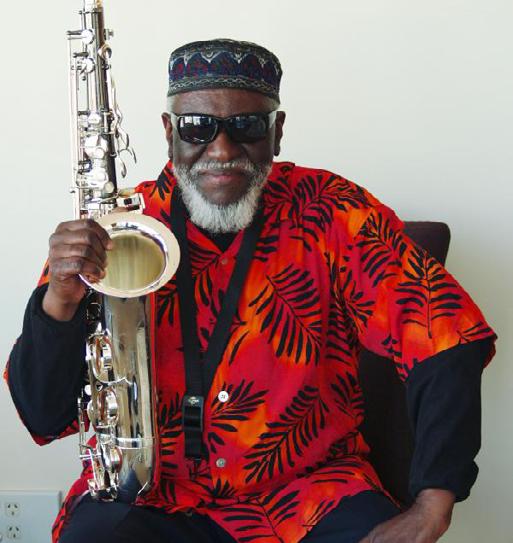
Pharoah Sanders: A Sound ‘Instantly Commanding and Recognizable’
“Listening to Pharoah warm up backstage felt like someone sticking an electric prong into your spine that suddenly connected you to another universe.” That was part of a Facebook post by drummer Will Calhoun after learning of tenor saxophonist Pharoah Sanders’ death on September 24, 2022, at the age of 81. Calhoun played on five tours with Sanders and his time with the tenor saxophonist “was invaluable.”
In a review of a 2003 Tokuma Records updated version of Sanders’ classic 1969 RCA Studios album, The Creator Has a Master Plan, Judith Schlesinger of AllMusic pointed out that, “Pharoah Sanders is
one of the few horn players whose sound is instantly commanding and recognizable. He’s often compared to John Coltrane in their similar power, spirituality, and preference for the meaty middle register of the tenor, and in fact, one of the selections here is a long, atmospheric meditation on Coltrane’s ‘Welcome’. This CD is a rare treat, since Sanders has not been recording as prolifically as he did in the first four decades of his career. If he’s not quite as pyrotechnic as before, his sound and soul are undiminished, and he’s still coming up with unusual timbres.”
Sanders’ defining solo work, according to NPR’s Nate Chinen, took
42 OCTOBER 2022 JERSEY JAZZ NJJS.ORG
BAND IN THE SKY
BIG
PHOTO BY QUENTIN LEBOUCHER FOR ARTS.GOV
BIG BAND IN THE SKY
place on Impulse! Records in the 1970s with such albums as Black Unity and Thembi (both in 1971). Impulse! was the same label that Coltrane recorded on. It was, Chinen wrote “a welcoming harbor for experimentalism.” Sanders, born in Little Rock, AK, on October 13, 1940, moved to the West Coast when he was about 19 and met Coltrane while attending Oakland (CA) Junior College where he sat in with avant-garde saxophonists like Sonny Simmons and Dewey Redman. He moved to New York in 1961 and, by 1965, was a member of Coltrane’s last quartet. “Spirit,” wrote Chinen, “was the overwhelming force
in Sanders’ music. It emanated from his tenor and soprano saxophones in fiery blasts or a murmuring flicker, and it suffused his ensembles, which featured several generations of improvisers willing to dig in or soar free.”
In 2016, Sanders was named a National Endowment for the Arts Jazz Master. In a video made in appreciation of his award, the saxophonist Kamasi Washington said, “It’s like taking fried chicken and gravy to space and having a picnic on the moon, listening to Pharoah.” Saxophonist Lakecia Benjamin added, “It’s like he’s playing pure light at you. It’s way beyond the language. It’s way beyond the emotion.”
“ SPIRIT WAS THE OVERWHELMING FORCE IN SANDERS’ MUSIC. ”
Sue Mingus: Powerful Promoter of Her Husband’s Legacy
Sue Mingus, who was named the recipient of the 2023 A.B. Spellman National Endowment for the Arts Jazz Masters Fellowship for Jazz Advocacy, passed away on September 24, 2022, at the age of 92. The widow of legendary bassist/composer Charles Mingus, she was a powerful advocate for her husband’s legacy.
As the driving force behind the creation of the Mingus Big Band, Mingus Dynasty, and Mingus Orchestra, she kept her husband’s music alive through performances and recordings. As Musical Director of the Mingus Orchestra in 2011, she won a Grammy Award for Best Large Jazz Ensemble Album for Mingus Big Band Live At Jazz Standard (Jazz Workshop, Inc., Sue Mingus Music).
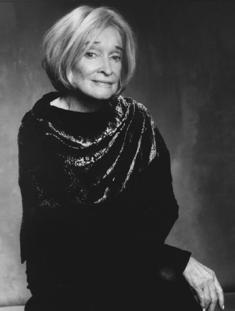
A journalist, she met Mingus in 1964 at New York’s Five Spot jazz club where he was performing. In addition to becoming his partner, she became his manager and oversaw Jazz Workshop, a music publishing company he created to preserve control over his music. He died in 1979 at the age of 56 from ALS.
In 1986, Sue Mingus founded a nonprofit organization, Let My Children Hear Music, Inc., to promote her husband’s legacy through publishing,
43 OCTOBER 2022 JERSEY JAZZ NJJS.ORG
BIG BAND IN THE SKY
education, archival presentation, and performance. The organization received five NEA grants. Three years later, Mingus produced Charles Mingus’ epic work, Epitaph, featuring 31 musicians in an orchestra conducted by Gunther Schuller at a world premiere in Lincoln Center’s Alice Tully Hall. The project, supported by grants from the Ford Foundation and NEA, toured four other cities as well. In 2002, she published a memoir, Tonight at Noon: A Love Story (DaCapo Press: 2002). It was named a Los Angeles Times Best Book of the Year and a New York Times Notable Book.
Let My Children Hear Music, Inc., in 2009, presented the first Charles Mingus Festival & High School Competition at the Manhattan School of Music. The 14th festival was held in February of this year at the New School’s College of Performing Arts. It was part of a multi-month “Mingus 100” centennial celebration.
Multi-Reedist Lou Caputo: ‘Playing Straight-Ahead Music That Swings’
For years, Lou Caputo’s Not So Big Band was a regular attraction at the now defunct Garage in the West Village. More recently, multi-reedist Caputo, who died August 29, 2022, at the age of 74, could be seen leading
smaller groups at Carmine & Sons Pizzeria in Brooklyn and The Rum Bar in New York’s Hotel Edison.
AllAboutJazz’s Jack Bowers, reviewing the Not So Big Band’s 2016 album, Uh Oh! on JazzCat 47 Records, pointed out the band’s “relatively spare front line: two trumpets, three saxophones, trombone, and tuba.” Bowers added, however that, “There is nothing spare about the band’s ability to

sound like a credibly larger ensemble, nor its propensity to swing through a dozen well-framed charts ... This is a plucky Not So Big ensemble playing straight-ahead music that swings.”
A native of Williamsburg, Brooklyn, Caputo has played with a variety of jazz and show bands and appeared with pianists Billy Taylor, Duke Jordan and Jaki Byard; percussionists
Bobby Sanabria, Walter Perkins and Mousey Alexander; and vocalists
Dakota Staton, Shirley Bassey, and Bobby Short, among many others.
Bassist Brian Nalepka, who played with Caputo in the Stan Rubin Orchestra, described Caputo, on Facebook, as “a friend and ally to every musician. He always greeted you with a big smile. That’s how I’ll remember him!”
Caputo is survived by his wife, Patricia; daughter, Geraldine Digiglio; sons Christian and Matthew; and grandchildren, Daniel, Julia, Lily, and Charlotte.
44 OCTOBER 2022 JERSEY JAZZ NJJS.ORG
Chuck Folds: One of the Last of the Stride ‘Professors’
We learned recently of the death this past summer of stride pianist Chuck Folds at the age of 84. I interviewed Folds in 1978 for a newspaper article on Fats Waller that eventually became a chapter in my book, Jazz Notes: Interviews Across the Generations (Praeger/ ABC-Clio: 2009). I asked him about drummer Sonny Greer’s story to me about how Waller wrote “Ain’t Misbehavin’” on the back of a menu from Jack Dempsey’s Broadway restaurant.
Folds said that was entirely possible because Eddie Condon always called Waller “a last-minute guy.” That, added Folds, was because “he had all this music bubbling inside of him.” I also asked Folds to describe how stride differed from ragtime. He called it “basically a rhythmical difference. In both
ragtime and stride piano, the key thing is the feeling. Stride became a looser thing. The essential vocabulary’s the same,” he said, “except that ragtime is limited to simplistic harmonies –they’re very nice, but they’re limited, considering what came later. By the time Fats Waller started recording for Victor in 1935, that was the beginning of the swing era, so Fats swung, whereas most ragtime doesn’t by our standards.”
The lack of information or news about Folds’ passing was disappointing. I learned about it in an email from Jersey Jazz columnist Dan Morgenstern, who had heard about it from pianist/vocalist Daryl Sherman. There was virtually nothing online until I finally came across “Barry Singer (on The ARTS and Otherwise)”, an online newsletter by author Barry Singer, who wrote Black and Blue: The Life and Lyrics of Andy Razaf (Schirmer Reference: 1995). In a post dated July 30, Singer wrote, “This is about

Chuck Folds, one of the finest jazz pianists that I ever heard, who passed away last month with barely a sound.”
Singer described Folds as “one of the last of stride piano ‘professors’, in a direct line from James P. Johnson and Willie ‘The Lion’ Smith through ‘Fats’ Waller, to Joe Sullivan, Ralph Sutton, and Dick Wellstood.” He also pointed out that Folds played with trumpeter Doc Cheatham for 25 years until Cheatham’s death in 1997 and performed for the same number years in the lobby of the Park Avenue Plaza building on East 55th Street, just opposite Singer’s bookstore, Chartwell Booksellers.
Folds, according to Singer, was born on May 4, 1938, in Cambridge, MA, and grew up in Exeter, NH, and Evanston, IL. His mother played classical piano at home, and his father taught art history at Phillips Exeter Academy before chairing the Art Department at Northwestern University. Folds entered Yale in 1956 but often slipped into New York to hear such musicians as Miles Davis, Roy Eldridge, and Charles Mingus. His first professional job was at Club Basin Street in Chicago.
In 1960, Folds moved to New York and eventually played practically everywhere – from the Rainbow Room to Michael’s Pub to the Cookery. The last time I saw him was sometime in the early 2000s at Sweet Basil’s in Greenwich Village. My college-age older son had become a fan of the alternative rock group, the Ben Folds Five, and I was curious if Ben was related to Chuck. He wasn’t, but Chuck said I wasn’t the first person to ask that. —SJ
45 OCTOBER 2022 JERSEY JAZZ NJJS.ORG
IN THE SKY
BIG BAND
Your membership is vital to NJJS’s mission to promote and preserve America’s great art form— JAZZ!
NOT WITHOUT YOU!
NEW MEMBERS
Christopher Brown RINGWOOD, NJ
Rose Marie Campano BERKELEY HEIGHTS, NJ
Alvaro Caravaca MT. OLIVE, NJ
Carlos Jimenez WHITE PLAINS, NY
Sam Konin LAWRENCEVILLE, NJ
Arthur Kramer FAIR LAWN, NJ
THANK YOU and welcome to all who have recently joined or renewed their memberships. We can’t do what we do without you! NJJS org
Ginger Meyer CHESTER, NJ
David Silberberg MILLBURN, NJ
Gary Walker BLOOMFIELD, NJ
RENEWAL MEMBERS
Elaine Dolsky PARSIPPANY, NJ
Alan Eisenberg ROCKVILLE, MD
Ellen Krueger CHATHAM, NJ
Trineice Robinson-Martin LAWRENCEVILLE, NJ
Mecadon McCune NEWARK, NJ
Thomas Hyland PITTSTOWN, NJ
Laura Hull FLANDERS, NJ
Ed Linehan SARASOTA, FL
Antoinette Montague NEWARK, NJ
Arthur Markowitz MAHWAH, NJ
David Orthmann NEWFOUNDLAND, NJ
David Post HOBOKEN, NJ
Enrique Roibal BUDD LAKE, NJ
Don Jay Smith LEBANON, NJ
Dave Spinelli RINGWOOD, NJ
Sam Testa SCOTCH PLAINS, NJ
Max Webb ARLINGTON, VA




















































